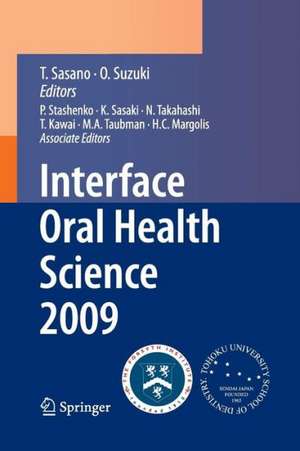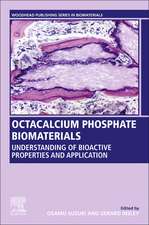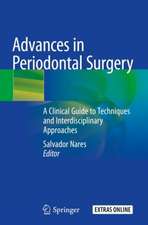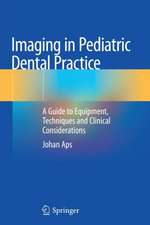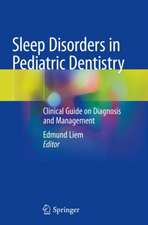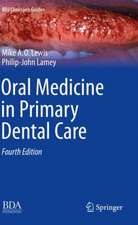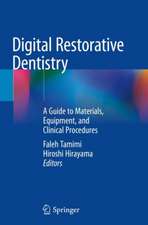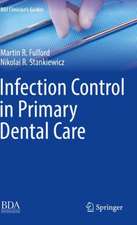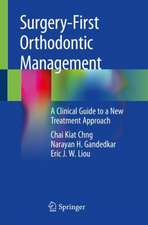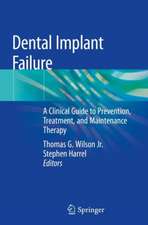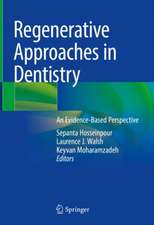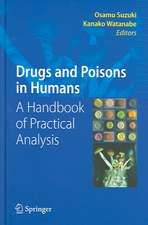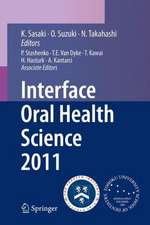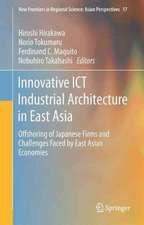Interface Oral Health Science 2009: Proceedings of the 3rd International Symposium for Interface Oral Health Science, Held in Sendai, Japan, Between January 15 and 16, 2009 and the 1st Tohoku-Forsyth Symposium, Held in Boston, MA, USA, Between March 10 and 11, 2009
Editat de Takashi Sasano Nobuhiro Takahashi, Keiichi Sasaki Editat de Osamu Suzuki Philip Stashenko, Toshihisa Kawai, Martin A. Taubman, Henry C. Margolisen Limba Engleză Paperback – 10 noi 2014
| Toate formatele și edițiile | Preț | Express |
|---|---|---|
| Paperback (1) | 1607.94 lei 6-8 săpt. | |
| Springer – 10 noi 2014 | 1607.94 lei 6-8 săpt. | |
| Hardback (1) | 1425.76 lei 6-8 săpt. | |
| Springer – 21 apr 2010 | 1425.76 lei 6-8 săpt. |
Preț: 1607.94 lei
Preț vechi: 1692.57 lei
-5% Nou
Puncte Express: 2412
Preț estimativ în valută:
307.71€ • 334.13$ • 258.48£
307.71€ • 334.13$ • 258.48£
Carte tipărită la comandă
Livrare economică 22 aprilie-06 mai
Preluare comenzi: 021 569.72.76
Specificații
ISBN-13: 9784431547044
ISBN-10: 4431547045
Pagini: 460
Ilustrații: XXIII, 435 p.
Dimensiuni: 155 x 235 x 24 mm
Greutate: 0.64 kg
Ediția:2010
Editura: Springer
Colecția Springer
Locul publicării:Tokyo, Japan
ISBN-10: 4431547045
Pagini: 460
Ilustrații: XXIII, 435 p.
Dimensiuni: 155 x 235 x 24 mm
Greutate: 0.64 kg
Ediția:2010
Editura: Springer
Colecția Springer
Locul publicării:Tokyo, Japan
Public țintă
Professional/practitionerDescriere
Since 2002, the Tohoku University Graduate School of Dentistry has proposed “Interface Oral Health Science” as a major theme for next-generation dental research. That theme is based on the following new concept: healthy oral fu- tion is maintained by biological and biomechanical harmony among three s- tems: (1) oral tissues (host); (2) parasitic microorganisms of the oral cavity (parasites); and (3) biomaterials. The concept implies that oral diseases such as dental caries, periodontal disease, and temporomandibular disorders should be interpreted as “interface disorders” that result from disruption of the intact int- face among these systems. The uniqueness of this concept rests on the fact that it not only encompasses the field of dentistry and dental medicine, but also expands the common ground shared with other fields, including medicine, ag- culture, material science, engineering, and pharmacology. We aim to promote advances in dental research and to activate collaboration with related fields by putting interface oral health science into practice. On this basis, we have already organized the 1st and 2nd International Symposiums for Interface Oral Health Science, which included inspiring special lectures, symposiums, poster pres- tations, and other discussions. The contents of the two symposiums were p- lished as monographs entitled Interface Oral Health Science in 2005 and 2007. The 3rd International Symposium was held in January 2009 as part of this project.
Cuprins
Plenary Lecture.- Shear-stress-sensing and response mechanisms in vascular endothelial cells.- Novel Bioengineering.- Cleft formation and branching morphogenesis of salivary gland: exploration of new functional genes.- Strategies underlying research in tooth regenerative therapy as a possible model for future organ replacement.- Molecular basis for specification of the vertebrate head field.- Dental epithelium proliferation and differentiation regulated by ameloblastin.- Mechanobiology.- Stress fiber and the mechanical states in a living endothelial cell.- Transient receptor potential channels and mechanobiology.- Molecular mechanisms of the response to mechanical stimulation during chondrocyte differentiation.- Recruitment of masseter motoneurons by spindle Ia inputs and its modulation by leak K+ channels.- Biomaterial Interface.- Implant interface to bone tissue: biomimetic surface functionalization through nanotechnology.- Interface affinity between apatites and biological tissues.- Biological reactions on titanium surface electrodeposited biofunctional molecules.- Effect of Young’s modulus in metallic implants on atrophy and bone remodeling.- Chemical and physical factors affecting osteoconductivity of octacalcium phosphate bone substitute material.- Biomechanical–Biological Interface.- Effects of zebularine on the apoptosis of 5-fluorouracil via cAMP/PKA/CREB pathway in HSC-3 cells.- Wnt signaling inhibits cementoblast differentiation.- Prevention of necrotic actions of nitrogen-containing bisphosphonates (NBPs) in mice by non-NBPs (clodronate and etidronate).- Interface, implant, regenerated bone and recipient alveolar bone.- Activation of matrix metalloproteinase-2 at the interface between epithelial cells and fibroblasts from human periodontal ligament.- Histomorphometric study of alveolar bone-implant (miniscrew) interface used as an orthodontic anchorage.- Mechanical stress modulates bone remodeling signals.- Expression analysis of p51/p63 in enamel organ epithelial cells.- Osteogenesis by gradually expanding the interface between bone surface and periosteum: preliminary analysis of the use of novel plate and bone marrow stem cell administration in rabbits.- Possible role of Ccn family members during osteoblast differentiation.- Inhibition of oral fibroblast growth and function by N-acetyl cysteine.- Computer simulation of orthodontic tooth movement using FE analysis.- Mechanical-stress-induced apoptosis and angiogenesis in periodontal tissue.- Diachronic changes of tooth wear in the deciduous dentition of the Japanese.- Dental occlusal deformation analysis of porcine mandibular periodontium using digital image correlation method.- Measurement of the transmitted-light through human upper incisors.- Three-dimensional finite element analysis of overload-induced alveolar bone resorption around dental implants.- Regulation of microrna expression by bone morphogenetic protein-2.- Influence of early progressive loading on implants placed into extraction sockets.- In vitro gene transfection of human stromal cell derived factor-1? and its expression in rat myoblasts.- Biomarker identification in oral cancer by using proteomics.- In vivo analysis of the 3-D force on implants supporting fixed prostheses.- Gap junctional communication regulates salivary gland morphogenesis.- Pulpal blood flow in human permanent teeth with different root formation.- Immunohistological study on stro-1 in developing rat dental tissues with light and electron microscopy.- The physiological calcification process is replicated in a rat embryonic calvarial culture.- Tonometric measurement of the gingiva in young and elder humans.- Isolation and comparison of mesenchymal stem cells derived from human wisdom tooth germs and periodontal ligament in vitro.- Unitary discharges of TMJ mechanosensitive neurons during cortically induced jaw movement.- Evaluation of bone metabolism of temporomandibular joint by using high resolution PET scanner.- Physiological role of type II bone morphogenetic protein receptor and its interacting molecules in bone morphogenetic protein signaling.- Role of the protein serine/threonine phosphatase dullard in cell differentiation.- The role of extracellular signal-regulated kinase 5 signaling pathway in neurons.- Regulation of bone morphogenetic protein-mediated signaling by tumor necrosis factor-?.- Mechanosensitive TRP channels in osteoblasts.- Immunohistochemical localization of CD134 ligand, CD137 ligand, GITR ligand, and BAFF in Sjögren’s syndrome-like autoimmune sialadenitis of MRL/lpr mice.- Expression of microrna during tooth development.- Host-Parasite Interface.- New quantitative fluorometry for evaluating oral bacterial adhesion to biomaterials.- Analgesic effects of NOD1 and NOD2 agonists.- Porphyromonas gingivalis-induced alveolar bone loss in interleukin-18 transgenic mice.- Anaphylaxis-like shock induced by LPS plus antineutrophil monoclonal antibodies in mice.- Concentrations of metal ions in murine nickel allergy and its cross-reactions: effects of lipopolysaccharide.- Muramyldipeptide augments the actions of LPS via multiple fashions in mice.- Isolation and identification of viable bacteria within acrylic resin denture bases.- Bactericidal effect of photodynamic therapy.- Induction of Tregs from PBMC by interacting with immunosuppressive molecule B7-H3 on oral mesenchymal stem cells.- A method for determining the profiles of biomass volume and glucan within dental plaque.- Porphyromonas gingivalis is widely distributed in subgingival plaque biofilm of elderly subjects.- Profiling of dental plaque microflora on root caries lesions and the protein-degrading activity of these bacteria.- Characterization of glucosyltransferases synthesizing (1?6)-?-D-glucan from Streptococcus sobrinus and Streptococcus downei.- Profiling of dental plaque biofilm on first molars with orthodontic bands and brackets.- Hydrogen-sulfide production from various substrates by oral Veillonella and effects of lactate on the production.- Denture plaque removal efficacy of denture cleansing device utilizing radical disinfection ability of activated low concentration H2O2.- Detection of herpes simplex virus type 1 in human cadaver trigeminal ganglia.- Transmitted laser beam power of the resin washed by experimental washing machine for dentures.- The evaluation of the dental disinfection device with low concentration of H2O2 and laser diode.- Rapid identification of HACEK group bacteria using 16S rRNA gene PCR-RFLP.- A novel aspartate-specific dipeptidylpeptidase produced from Porphyromonas endodontalis.- Short-term effect of single NaF-mouthrinse on glucose-induced pH fall in dental plaque.- Short-time effect of fluoride on acid production by Streptococcus mutans.- Real-time PCR analysis of cariogenic bacteria in supragingival plaque biofilm microflora on caries lesions of children.- Involvement of cough reflex impairment and silent aspiration of oral bacteria in postoperative pneumonia: a model of aspiration pneumonia.- The production of secretory leukocyte protease inhibitor from gingival epithelial cells in response to Porphyromonas gingivalis lipopolysaccharides.- Analysis of antigen incorporating and processing cells in sublingal immunotherapy.- Acoustic mineral density measurement to evaluate clinical demineralized lesions.- Biometrial Interface.- Experimental Ti–Ag alloys inhibit biofilm formation.- Apatite formation from octacalcium phosphate with fluoride.- Effect of topography of the octacalcium phosphate granule surfaces on its bone regenerative property.- The influence of sericin solution on wettability and antifungal effect of resin surface.- Adhesives and resin composites as functional units.- Effects of bisphosphonates on bone marrow stromal cells.- Tooth shape reconstruction from dental micro CT images.- Formation of hydroxyapatite film on tooth using powder-jet-deposition.- Electrodeposition of apatite onto titanium substrates under pulse current.- Alginate/octacalcium phosphate composites enhance bone formation in critical-sized mouse calvaria defects.- Strength of porcelain fused to Ti-20% Ag alloy made by CAD/CAM.- Effect of various solutions to exudation of internal fluids from dentinal tubules.- Evaluation of retentive force of ?-type Ti–6Mo–4Sn alloy wire to apply for the abutment tooth of removable partial denture.- Medical application of magnesium and its alloys as degradable biomaterials.- Social Interface.- Difference between age generation of oral health examination in a rural town.- Impact of oral health status on healthy life expectancy in community-dwelling population: The AGES Project cohort study.- Wireless magnetic motion capture system for medical use.- Evaluation of the optimal time of the dental treatment for the elderly.- Educational effect on tooth preparation of visual feedback using computer graphics.- Japanese men OSAHS patient’s anatomical features.- Association between periodontal disease and risk for atherosclerosis in hypertensive patients.- Leading a patient to a dental office: the evaluation of pain and stress during the dental treatment using an air-pad sensor system.- Can symptom awareness of the elderly be a clue to find oral diseases and promote oral health behaviors?.- The study of mandibular position applied to oral appliance for treatment of obstructive sleep apnea syndrome.- Prediction of future number of remaining teeth of Japanese elderly, based on data from the national survey of dental diseases in Japan.- National survey on the school-based fluoride mouth rinsing program in Japan: proposition regarding final assessment of Healthy Japan 21 in 2010, and in 2020.- A new intra-oral pressure monitor for screening swallowing dysfunction.- A numerical simulation method for dental occlusion with forces applied to the tooth in mandible.- Tohoku-Forsyth Symposium.- Osteopontin and CSF-1 in bone resorption.- Role of amelogenin self-assembly in protein-mediated dental enamel formation.- The human genetics of amelogenesis imperfecta.- Porphyromonas gingivalis: surface polysaccharides as virulence determinants.- Building the genomic base-layer of the oral “omic” world.- Cariogenic microflora and the immune response.- Porphyromonas gingivalis infection elicits immune-mediated RANKL-dependent periodontal bone loss in rats.- Is RANKL shedding involved in immune cell-mediated osteoclastogenesis?.- Possible IgG transportation mechanism mediated by neonatal Fc receptor expressed in gingival epithelial cells.- Effects of extracellular adenosine on sRANKL production from activated T cells.- Activation of the critical enamel protease kallikrein-4.- Epitopes shared among pioneer oral flora and Streptococcus mutans GbpB.- Inhibitory effect of porcine amelogenins on spontaneous mineralization.- A stress-based mechanism to explain dental fluorosis.
Caracteristici
Includes supplementary material: sn.pub/extras
